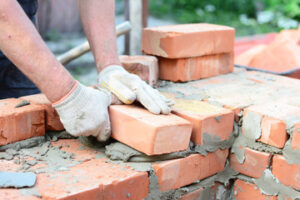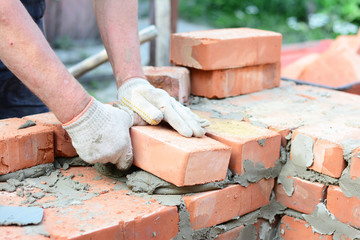Brick Masonry Charleston SC is the process of building structures using individual units laid in mortar. These units are then connected together to create a building. Brick masonry is often associated with the construction of residential homes. This type of masonry can be used for a variety of purposes, including the construction of fences, bridges, and many other structures.
Brick masonry is generally divided into two types: header and stretcher bonds. Header bond brickwork consists of bricks that have a shorter face. Header bonds overlap at half the brick’s width. Header bond brickwork is often used for thick walls that are not required to be symmetrical. Flemish bond brickwork alternates header and stretcher bricks in alternate courses.
Brick masonry is an attractive and affordable option for building homes and other structures. It can be made of clay, sand, and other minerals. It is easy to manufacture and can be tailored to the specifications of the construction site. Because brick masonry is made from natural materials, it has a longer life cycle and is free of contaminants.
Brick walls are commonly insulated. Brick veneer walls are built before sheathing and are often insulated. Metal ties are used to secure the bricks to the studs. These metal ties are then nailed into the studs, bent in a horizontal position, and become embedded in the mortar joints. Generally, brick veneer walls are built on the outer edge of the foundation wall with about one inch of air space between the bricks.
One common problem with brick masonry is moisture. While brick is a natural material, it is not waterproof. The surface of the brick will be treated with tar paper to minimize moisture from entering the wall. It is important to consider the moisture content of your local area when choosing the brick for your home. In this case, you should choose a higher-quality brick. You can also consider installing a weep hole at the base of the brick veneer.
Brick masonry can vary from mud brick masonry to cement brick masonry construction. The difference between the two types is in the amount of mortar used. The thickness of the mortar joint should be between twelve and eighteen millimeters. Using the wrong mortar can result in weaker brickwork.
Bricks are still one of the most common building materials in the world. They are made from clay and shale and fired at about 2,000 degrees Fahrenheit. Bricks are also joined together with mortar, which must be precisely mixed and placed. If you want a durable, long-lasting building, choose brick masonry. You can also use manufactured stone and glass bricks. Just be sure to consider the materials and the installation method before you start your next project.
Brick masonry is easy to fix if something goes wrong. A skilled bricklayer will be able to cover up any mistakes with plaster. Also, bricks are light and easy to handle. Whether you need to repair a brick or build a new wall, you can hire someone with the right knowledge and experience to complete the project.
To build a brick masonry building, you need to know how to lay individual bricks in mortar. Bricks are tied together using a mortar and are usually placed in a specific bonding pattern. Some methods of brick masonry include stretcher bricks that are laid parallel to the face of the wall. Another method is known as stranger routes.
Brick masonry is generally made of many different types of bricks. Each brick has a different function. Some are used for coping bricks, while others are used for the backing. Depending on the purpose of the brick, it can be of different sizes and shapes. There are many ways to make brick walls, but the most common method is to use header and stretcher bond.
Thermal conductivity is a key aspect in brick masonry walls, as a wall with a high thermal conductivity will be more energy-efficient than one with a low one. The geometry of hollow bricks can be designed to increase thermal conductivity as an organic material. Further, the use of organic materials in brick masonry reduces thermal conductibility and transmittance.

